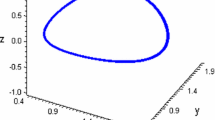Abstract
The dynamics of the classical biological Lotka–Volterra system with a seasonality factor is investigated analytically. The original model is described by a simple Hamiltonian. To reveal the chaotic behavior in the system, the Hamiltonian is represented by a sum of a Hamiltonian that is independent of time and a number of resonances. The investigation of the interaction of these resonances using Chirikov’s resonance overlap method makes it possible to find an analytical criterion in terms of the critical values of the seasonality amplitudes under which the original system goes to chaos. The results of the study show that in the presence of a periodic perturbation (the seasonality factor in the case under consideration) the system with two dependent variables demonstrates chaotic behavior.
Similar content being viewed by others
REFERENCES
V. Volterra, “Fluctuations in the abundance of a species considered mathematically,” Nature 118, 558–560 (1926). https://doi.org/10.1038/118558a0
V. Volterra, “Variazioni e fluttuazioni dei numero d’individui in specie animali conviventi,” Memorie della Regia Accademia Nazionale dei Lincei 2, 31–113 (1926). English translation in R. N. Chapman, Animal Ecology (McGraw–Hill, New York, 1931).
V. Volterra, Lessons on the Mathematical Theory of Struggle for Life (Gauthier-Villars, Paris, 1931).
A. J. Lotka, Elements of Physical Biology (Williams and Wilkins, Baltimore, 1925).
B. V. Chirikov, “A universal instability of many-dimensional oscillator systems,” Phys. Rep. 52, 263–379 (1979).
H. Poincaré, Les méthodes nouvelles de la mécanique céleste, Vols. 1–3 (Gauthier-Villars, Paris, 1892).
H. Poincaré, Leçons de mécanique céleste (Gauthier-Villars, Paris, 1905).
J. S. Hadamard, “Sur le billard non-Euclidien,” Soc. Sci. Bordeaux, Procès Verbaux (1898).
E. N. Lorenz, “Deterministic nonperiodic flow,” J. Atmos. Sci. 20 (2), 130–141 (1963). https://doi.org/10.1175/1520-0469(1963)020<0130:DNF>2.0.CO;2
E. N. Lorenz, “Predictability: Does the flap of a butterfly’s wings in Brazil set off a Tornado in Texas?” Am. Assoc. Advancement Sci. (1972). http://gymportalen.dk/sites/lru.dk/files/lru/132_kap6_lorenz_artikel_the_butterfly_effect.pdf
M. J. Feigenbaum, “Quantitative universality for a class of nonlinear transformations,” J. Stat. Phys. 19, 25–52 (1978). https://doi.org/10.1007/BF01020332
M. J. Feigenbaum, “The universal metric properties of nonlinear transformations,” J. Stat. Phys. 21, 669–706 (1979). https://doi.org/10.1007/BF01107909
M. J. Feigenbaum, J. M. Greene, R. S. MacKay, and F. Vivaldi, “Universal behaviour in families of area-preserving maps,” Physica D: Nonlinear Phenomena 3, 468–486 (1981). https://doi.org/10.1016/0167-2789(81)90034-8
B. B. Mandelbrot, The Fractal Geometry of Nature (Freeman, New York, 1982).
E. Ott, C. Grebogi, and J. A. Yorke, “Controlling chaos,” Phys. Rev. Lett. 64, 1196–1199 (1990). https://doi.org/10.1103/PhysRevLett.64.1196
L. M. Pecora and T. L., Carroll, “Synchronization in chaotic systems,” Phys. Rev. Lett. 64, 821–824 (1990). https://doi.org/10.1103/PhysRevLett.64.821
M. P. Fishman and D. A. Egolf. “Revealing the building block of spatiotemporal chaos: Deviations from extensivity,” Phys. Rev. Lett. 96 (5), (2006), Article ID 054103. https://doi.org/10.1103/PhysRevLett.96.054103
D. R. Spiegel and E. R. Johnson, “Experimental investigation of the transition to spatiotemporal chaos with a system-size control parameter,” Res. Lett. Phys. (2008), Article ID 891324. https://doi.org/10.1155/2008/891324
E. Benincà, B. Ballantine, S. P. Ellner, and J. Huisman, “Species fluctuations sustained by a cyclic succession at the edge of chaos, Proc. Nat. Acad. Sci. USA 112, 6389–6394 (2015). https://doi.org/10.1073/pnas.1421968112
C. F. Clements and A. Ozgul, “Indicators of transitions in biological systems,” Ecol. Lett. 21, 905–919 (2018). https://doi.org/10.1111/ele.12948
M. Scheffer, J. Bascompte, W. Brock, et al. “Early-warning signals for critical transitions,” Nature 461, 53–59 (2009). https://doi.org/10.1038/nature08227
E. Gopalakrishnan et al. “Early warning signals for critical transitions a thermoacoustic system,” Sci. Rep. 6, 1–10 (2016), Article number: 35310. https://doi.org/10.1038/srep35310
M. C. Boerlijst, T. Oudman, and A. M. de Roos, “Catastrophic collapse can occur without early warning: Examples of silent catastrophes in structured ecological models,” PLOS ONE 8 (1), 1–6 (2013). https://doi.org/10.1371/journal.pone.0062033
T. Peacock and G. Haller, “Lagrangian coherent structures. The hidden skeleton of fluid flows,” Phys. Today. 41 (2013).
M. Mathur, G. Haller, T. Peacock, J. E. Ruppert-Felsot, and H. L. Swinney, “Uncovering the Lagrangian skeleton of turbulence,” Phys. Rev. Lett. 98, 144502-1–144502-4 (2007). https://doi.org/10.1103/PhysRevLett.98.144502
M. V. Falessi, F. Pegoraro, and T. J. Schep, “Lagrangian coherent structures and plasma transport processes,” J. Plasma Phys. 81 (5), (2015). https://doi.org/10.1017/S0022377815000690
E. T. Kai, V. Rossi, J. Sudre, H. Weimerskirch, C. Lopez, E. Hernandez-Garcia, F. Marsac, and V. Garcon, “Top marine predators track Lagrangian coherent structures,” Proc. Nat. Acad. Sci. USA 106, 8245–8250 (2009).
H. Zhu, S. C. Chapman, and R. O. Dendy, “Robustness of predator-prey models for confinement regime transitions in fusion plasmas,” Phys. Plasma 20, 042302-1–042302-11 (2013). https://doi.org/10.1063/1.4800009
E. Aydiner, “Chaotic universe model: Lotka-Volterra dynamics of the universe evolution.” (2017). arXiv: 1610.07338v3 [gr-qc]
P. Gatabazi, J. C. Mba, and E. Pindza, “Fractional gray Lotka-Volterra models with application to cryptocurrencies adoption,” Chaos 29 (7), 10 (2019). https://doi.org/10.1063/1.5096836
A. Arneodo, P. Coullet P., J. Peyraud, et al. “Strange attractors in Volterra equations for species in competition,” J. Math. Biol. 14 (2), 153–157 (1982). https://doi.org/10.1007/BF01832841
A. Arneodo, P. Coullet, and C. Tresser, “Occurrence of strange attractors in three-dimensional Volterra equations,” Phys. Lett. A 79 (4), 259–263 (1980). https://doi.org/10.1016/0375-9601(80)90342-4
R. Wang and D. Xiao, “Bifurcations and chaotic dynamics in a 4-dimensional competitive Lotka–Volterra system,” Nonlinear Dyn. 59, 411–422 (2010). https://doi.org/10.1007/s11071-009-9547-3
J. A. Vano, J. C. Wildenberg, M. B. Anderson, J. K. Noel, and J. C. Sprott, “Chaos in low-dimensional Lotka–Volterra models of competition,” Nonlinearity 19, 2391–2404 (2006). https://doi.org/10.1088/0951-7715/19/10/006
V. Kozlov and S. Vakulenko, “On chaos in Lotka–Volterra systems: An analytical approach,” Nonlinearity 26, 2299–2314 (2013). https://doi.org/10.1088/0951-7715/26/8/2299
J. R. Christie, K. Gopalsamy, and J. Li, “Chaos in perturbed Lotka–Volterra systems,” Austr. New Zealand Industr. Appl. Math. J. 42, 399–412 (2001). https://doi.org/10.1017/S1446181100012025
Author information
Authors and Affiliations
Corresponding author
Additional information
Translated by A. Klimontovich
Rights and permissions
About this article
Cite this article
Bibik, Y.V. Analytical Investigation of the Chaotic Dynamics of a Two-Dimensional Lotka–Volterra System with a Seasonality Factor. Comput. Math. and Math. Phys. 61, 226–241 (2021). https://doi.org/10.1134/S0965542521010024
Received:
Revised:
Accepted:
Published:
Issue Date:
DOI: https://doi.org/10.1134/S0965542521010024




